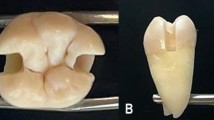Abstract
The aim of this study was to evaluate internal and marginal adaptation of high-viscosity bulk-fill composites to enamel and dentin with a self-etch (SE) and an etch-and-rinse adhesive (ER) without and with artificial aging. 128 MOD cavities in extracted human molars were prepared, randomly assigned to 8 groups (n = 16), bonded with either OptiBond FL (OFL, ER) or Xeno V+ (X, SE), and restored in 4 mm horizontal bulk layers with SonicFill (SF), Tetric EvoCeram Bulk fill (TEC), and x-tra fil (XF). Incremental layering technique with Premise (P) served as control. Half of the specimens each (n = 8) were subjected either to water storage (1 day, 37 °C) or prolonged storage (180 days) and thereafter thermocycling. Replicas were analyzed for marginal gap formation. After sectioning, interfacial adhesive defects were assessed. Results were statistical analyzed. (1) Internal adaptation: Except for TEC/OFL at enamel without artificial aging, no significant differences between bulk-fill composites and the control were observed. All groups at dentin with OFL showed less internal adhesive defects than that with X (p < 0.05). (2) Marginal adaptation: No significant differences were observed between bulk-fill composites and control except for P after artificial aging (p > 0.05). All other composites, regardless of artificial aging, formed significantly more marginal gaps at enamel with X compared to with OFL (p ≤ 0.05). Simplified restorations with high-viscosity bulk-fill composite showed comparable internal and marginal adaptation to incrementally placed fillings. A superiority of the 3-step ER approach was seen compared to the 1-step SE adhesive irrespective of the bulk-fill composite used.


Similar content being viewed by others
Change history
04 February 2019
In the original publication of the article the paragraph “The four resin-based composites…” appearing below the “Materials and methods” section is incomplete. The correct paragraph is provided in this correction below.
References
Opdam NJM, van de Sande FH, Bronkhorst E, Cenci MS, Bottenberg P, Pallesen U, Gaengler P, Lindberg A, Huysmans MCDNJM, van Dijken JW. Longevity of posterior composite restorations: a systematic review and meta-analysis. J Dent Res. 2014;93:943–9. https://doi.org/10.1177/0022034514544217.
van Dijken JW. Direct resin composite inlays/onlays: an 11 year follow-up. J Dent. 2000;28:299–306.
Demarco FF, Corrêa MB, Cenci MS, Moraes RR, Opdam NJM. Longevity of posterior composite restorations: not only a matter of materials. Dent Mater. 2012;28:87–101. https://doi.org/10.1016/j.dental.2011.09.003.
el-Mowafy OM, Lewis DW, Benmergui C, Levinton C. Meta-analysis on long-term clinical performance of posterior composite restorations. J Dent. 1994;22:33–43.
Cardoso MV, Almeida Neves A de, Mine A, Coutinho E, van Landuyt K, Munck J de, van Meerbeek B. Current aspects on bonding effectiveness and stability in adhesive dentistry. Aust Dent J. 2011;56(Suppl 1):31–44. https://doi.org/10.1111/j.1834-7819.2011.01294.x.
Ferracane JL. Developing a more complete understanding of stresses produced in dental composites during polymerization. Dent Mater. 2005;21:36–42. https://doi.org/10.1016/j.dental.2004.10.004.
Park J, Chang J, Ferracane J, Lee IB. How should composite be layered to reduce shrinkage stress: incremental or bulk filling? Dent Mater. 2008;24:1501–5. https://doi.org/10.1016/j.dental.2008.03.013.
Abbas G, Fleming GJP, Harrington E, Shortall ACC, Burke FJT. Cuspal movement and microleakage in premolar teeth restored with a packable composite cured in bulk or in increments. J Dent. 2003;31:437–44.
Kemp-Scholte CM, Davidson CL. Complete marginal seal of Class V resin composite restorations effected by increased flexibility. J Dent Res. 1990;69:1240–3.
Oliveira LCA, Duarte S, Araujo CA, Abrahão A. Effect of low-elastic modulus liner and base as stress-absorbing layer in composite resin restorations. Dent Mater. 2010;26:e159-69. https://doi.org/10.1016/j.dental.2009.11.076.
Haak R, Wicht MJ, Noack MJ. Marginal and internal adaptation of extended class I restorations lined with flowable composites. J Dent. 2003;31:231–9.
Menees TS, Lin CP, Kojic DD, Burgess JO, Lawson NC. Depth of cure of bulk fill composites with monowave and polywave curing lights. Am J Dent. 2015;28:357–61.
Vaidyanathan J, Vaidyanathan TK. Flexural creep deformation and recovery in dental composites. J Dent. 2001;29:545–51.
Braga RR, Ferracane JL. Contraction stress related to degree of conversion and reaction kinetics. J Dent Res. 2002;81:114–8.
Garcia D, Yaman P, Dennison J, Neiva G. Polymerization shrinkage and depth of cure of bulk fill flowable composite resins. Oper Dent. 2014;39:441–8. https://doi.org/10.2341/12-484-L.
Jang J-H, Park S-H, Hwang I-N. Polymerization shrinkage and depth of cure of bulk-fill resin composites and highly filled flowable resin. Oper Dent. 2015;40:172–80. https://doi.org/10.2341/13-307-L.
Kwon Y, Ferracane J, Lee I-B. Effect of layering methods, composite type, and flowable liner on the polymerization shrinkage stress of light cured composites. Dent Mater. 2012;28:801–9. https://doi.org/10.1016/j.dental.2012.04.028.
Ilie N, Kessler A, Durner J. Influence of various irradiation processes on the mechanical properties and polymerisation kinetics of bulk-fill resin based composites. J Dent. 2013;41:695–702. https://doi.org/10.1016/j.jdent.2013.05.008.
Furness A, Tadros MY, Looney SW, Rueggeberg FA. Effect of bulk/incremental fill on internal gap formation of bulk-fill composites. J Dent. 2014;42:439–49. https://doi.org/10.1016/j.jdent.2014.01.005.
Heintze SD. Systematic reviews: I. The correlation between laboratory tests on marginal quality and bond strength. II. The correlation between marginal quality and clinical outcome. J Adhes Dent. 2007;9(Suppl 1):77–106.
Park K-J, Schneider H, Haak R. Assessment of interfacial defects at composite restorations by swept source optical coherence tomography. J Biomed Opt. 2013;18:76018. https://doi.org/10.1117/1.JBO.18.7.076018.
Park K-J, Schneider H, Haak R. Assessment of defects at tooth/self-adhering flowable composite interface using swept-source optical coherence tomography (SS-OCT). Dent Mater. 2015;31:534–41. https://doi.org/10.1016/j.dental.2015.02.005.
Haak R, Schmidt P, Park K-J, Häfer M, Krause F, Ziebolz D, Schneider H. OCT for early quality evaluation of tooth-composite bond in clinical trials. J Dent. 2018;76:46–51. https://doi.org/10.1016/j.jdent.2018.06.007.
Häfer M, Schneider H, Rupf S, Busch I, Fuchß A, Merte I, Jentsch H, Haak R, Merte K. Experimental and clinical evaluation of a self-etching and an etch-and-rinse adhesive system. J Adhes Dent. 2013;15:275–86. https://doi.org/10.3290/j.jad.a29633.
Kim HJ, Park SH. Measurement of the internal adaptation of resin composites using micro-CT and its correlation with polymerization shrinkage. Oper Dent. 2014;39:70. https://doi.org/10.2341/12-378-L.
Braga RR, Ballester RY, Ferracane JL. Factors involved in the development of polymerization shrinkage stress in resin-composites: a systematic review. Dent Mater. 2005;21:962–70. https://doi.org/10.1016/j.dental.2005.04.018.
Tarle Z, Attin T, Marovic D, Andermatt L, Ristic M, Taubock TT. Influence of irradiation time on subsurface degree of conversion and microhardness of high-viscosity bulk-fill resin composites. Clin Oral Investig. 2015;19:831–40. https://doi.org/10.1007/s00784-014-1302-6.
Magne P, Malta DAMP, Enciso R, Monteiro-Junior S. Heat treatment influences monomer conversion and bond strength of indirect composite resin restorations. J Adhes Dent. 2015;17:559–66. https://doi.org/10.3290/j.jad.a35258.
Kim RJ, Kim YJ, Choi NS, Lee IB. Polymerization shrinkage, modulus, and shrinkage stress related to tooth-restoration interfacial debonding in bulk-fill composites. J Dent. 2015;43:430–9. https://doi.org/10.1016/j.jdent.2015.02.002.
Zorzin J, Maier E, Harre S, Fey T, Belli R, Lohbauer U, Petschelt A, Taschner M. Bulk-fill resin composites: polymerization properties and extended light curing. Dent Mater. 2015;31:293–301. https://doi.org/10.1016/j.dental.2014.12.010.
Al-Harbi F, Kaisarly D, Bader D, El GM. Marginal integrity of bulk versus incremental fill class II composite restorations. Oper Dent. 2015. https://doi.org/10.2341/14-306-L.
Leprince JG, Palin WM, Vanacker J, Sabbagh J, Devaux J, Leloup G. Physico-mechanical characteristics of commercially available bulk-fill composites. J Dent. 2014;42:993–1000. https://doi.org/10.1016/j.jdent.2014.05.009.
Ilie N, Bucuta S, Draenert M. Bulk-fill resin-based composites: an in vitro assessment of their mechanical performance. Oper Dent. 2013;38:618–25. https://doi.org/10.2341/12-395-L.
Frankenberger R, Tay FR. Self-etch vs etch-and-rinse adhesives: effect of thermo-mechanical fatigue loading on marginal quality of bonded resin composite restorations. Dent Mater. 2005;21:397–412. https://doi.org/10.1016/j.dental.2004.07.005.
Häfer M, Jentsch H, Haak R, Schneider H. A three-year clinical evaluation of a one-step self-etch and a two-step etch-and-rinse adhesive in non-carious cervical lesions. J Dent. 2015;43:350–61. https://doi.org/10.1016/j.jdent.2014.12.009.
Peumans M, Munck J de, Mine A, van Meerbeek B. Clinical effectiveness of contemporary adhesives for the restoration of non-carious cervical lesions. A systematic review. Dent Mater. 2014;30:1089–103. https://doi.org/10.1016/j.dental.2014.07.007.
van Meerbeek B, Yoshihara K, Yoshida Y, Mine A, Munck J de, van Landuyt KL. State of the art of self-etch adhesives. Dent Mater. 2011;27:17–28. https://doi.org/10.1016/j.dental.2010.10.023.
Inoue S, Koshiro K, Yoshida Y, Munck J de, Nagakane K, Suzuki K, Sano H, van Meerbeek B. Hydrolytic stability of self-etch adhesives bonded to dentin. J Dent Res. 2005;84:1160–4. https://doi.org/10.1177/154405910508401213.
Munck J de, Mine A, Poitevin A, van Ende A, Cardoso MV, van Landuyt KL, Peumans M, van Meerbeek B. Meta-analytical review of parameters involved in dentin bonding. J Dent Res. 2012;91:351–7. https://doi.org/10.1177/0022034511431251.
Roggendorf MJ, Kramer N, Appelt A, Naumann M, Frankenberger R. Marginal quality of flowable 4-mm base vs. conventionally layered resin composite. J Dent. 2011;39:643–7. https://doi.org/10.1016/j.jdent.2011.07.004.
Heintze SD, Monreal D, Peschke A. Marginal quality of class II composite restorations placed in bulk compared to an incremental technique: evaluation with SEM and stereomicroscope. J Adhes Dent. 2015;17:147–54. https://doi.org/10.3290/j.jad.a33973.
Breschi L, Mazzoni A, Ruggeri A, Cadenaro M, Di Lenarda R, De Stefano Dorigo E. Dental adhesion review: aging and stability of the bonded interface. Dent Mater. 2008;24:90–101. https://doi.org/10.1016/j.dental.2007.02.009.
Shirai K, Munck J de, Yoshida Y, Inoue S, Lambrechts P, Suzuki K, Shintani H, van Meerbeek B. Effect of cavity configuration and aging on the bonding effectiveness of six adhesives to dentin. Dent Mater. 2005;21:110–24. https://doi.org/10.1016/j.dental.2004.01.003.
Hashimoto M, Ohno H, Kaga M, Endo K, Sano H, Oguchi H. In vivo degradation of resin-dentin bonds in humans over 1 to 3 years. J Dent Res. 2000;79:1385–91. https://doi.org/10.1177/00220345000790060601.
Campos EA, Ardu S, Lefever D, Jasse FF, Bortolotto T, Krejci I. Marginal adaptation of class II cavities restored with bulk-fill composites. J Dent. 2014;42:575–81. https://doi.org/10.1016/j.jdent.2014.02.007.
Bayraktar Y, Ercan E, Hamidi MM, Colak H. One-year clinical evaluation of different types of bulk-fill composites. J Investig Clin Dent. 2016. https://doi.org/10.1111/jicd.12210.
Shahidi C, Krejci I, Dietschi D. In vitro evaluation of marginal adaptation of direct class II composite restorations made of different “low-shrinkage”. Syst Oper Dent. 2017;42:273–83. https://doi.org/10.2341/15-217-L.
Garcia-Godoy F, Krämer N, Feilzer AJ, Frankenberger R. Long-term degradation of enamel and dentin bonds: 6-year results in vitro vs. in vivo. Dent Mater. 2010;26:1113–8. https://doi.org/10.1016/j.dental.2010.07.012.
Flury S, Peutzfeldt A, Lussi A. Influence of increment thickness on microhardness and dentin bond strength of bulk fill resin composites. Dent Mater. 2014;30:1104–12. https://doi.org/10.1016/j.dental.2014.07.001.
Acknowledgements
The intact, non-carious, unrestored human molars were selected out of a pool of collected teeth in accordance with an approved protocol of the Ethics Committee of the University Leipzig, Germany (no. 299-10-04102010).
Author information
Authors and Affiliations
Corresponding author
Ethics declarations
Conflict of interest
The restoration materials were provided by Dentsply Sirona GmbH, Ivoclar Vivadent AG and Voco GmbH.
Additional information
Publisher’s Note
Springer Nature remains neutral with regard to jurisdictional claims in published maps and institutional affiliations.
The original version of this article was revised: In the original publication of the article the paragraph “The four resin-based composites…” appearing below the “Materials and methods” section is incomplete. The correct paragraph is provided in this correction below: The four resin-based composites were applied to the prepared cavities combined with each of the two adhesives (etch-and-rinse, ER; self-etch, SE). Table 1 shows the properties and composition of the materials used and supplementary table 1 summarizes the procedure of application.
Electronic supplementary material
Below is the link to the electronic supplementary material.
Rights and permissions
About this article
Cite this article
Haak, R., Näke, T., Park, KJ. et al. Internal and marginal adaptation of high-viscosity bulk-fill composites in class II cavities placed with different adhesive strategies. Odontology 107, 374–382 (2019). https://doi.org/10.1007/s10266-018-0402-1
Received:
Accepted:
Published:
Issue Date:
DOI: https://doi.org/10.1007/s10266-018-0402-1




